
The Great Salt Lake is the largest saltwater lake in the Western Hemisphere and the eighth-largest terminal lake in the world. It lies in the northern part of the U.S. state of Utah and has a substantial impact upon the local climate, particularly through lake-effect snow. It is a remnant of Lake Bonneville, a prehistoric body of water that covered much of western Utah.

A salt lake or saline lake is a landlocked body of water that has a concentration of salts and other dissolved minerals significantly higher than most lakes. In some cases, salt lakes have a higher concentration of salt than sea water; such lakes can also be termed hypersaline lakes, and may also be pink lakes on account of their colour. An alkalic salt lake that has a high content of carbonate is sometimes termed a soda lake.

The Province of Bumbunga was an Australian secessionist micronation located on a farm at Bumbunga near Snowtown and Lochiel, South Australia, from 1976 until approximately 2000. Its founder and only ruler was a British monkey trainer, uranium prospector, and postmaster named Alec Brackstone.
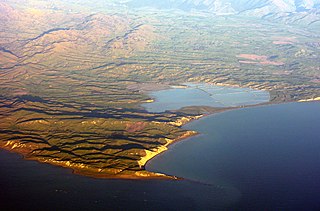
Lake Grassmere / Kapara Te Hau is a New Zealand waituna-type lagoon in the northeastern South Island, close to Cook Strait. The lake is used for the production of salt.

A salt evaporation pond is a shallow artificial salt pan designed to extract salts from sea water or other brines. The salt pans are shallow and expansive, allowing sunlight to penetrate and reach the seawater. Natural salt pans are formed through geologic processes, where evaporating water leaves behind salt deposits. Some salt evaporation ponds are only slightly modified from their natural version, such as the ponds on Great Inagua in the Bahamas, or the ponds in Jasiira, a few kilometres south of Mogadishu, where seawater is trapped and left to evaporate in the sun.

Snowtown is a town located in the Mid North of South Australia 145 km north of Adelaide and lies on the main road and rail routes between Adelaide and Perth – the Augusta Highway and Adelaide-Port Augusta railway line. The town's elevation is 103 metres and on average the town receives 389 mm of rainfall per annum.
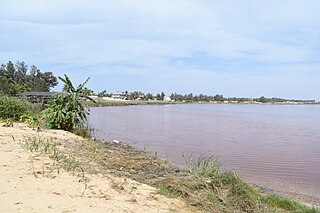
Lake Retba, also known as Lac Rose, lies north of the Cap Vert peninsula in Senegal, some 35 km (22 mi) north-east of the capital, Dakar, in northwest Africa. It is named for its pink waters caused by Dunaliella salina algae and is known for its high salt content, up to 40% in some areas. Its colour is usually particularly strong from late January to early March, during the dry season; however, flooding in September 2022 not only disrupted salt harvesting activities on the lake, but because it caused the lake to lose its colour, had a negative effect on tourism.
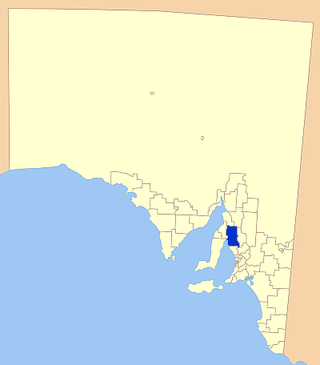
Wakefield Regional Council is a local government area in the Yorke and Mid North region of South Australia. The council seat is at Balaklava.
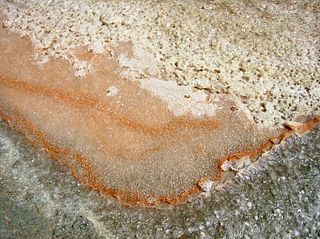
Dunaliella salina is a type of halophile unicellular green algae especially found in hypersaline environments, such as salt lakes and salt evaporation ponds. Known for its antioxidant activity because of its ability to create a large amount of carotenoids, it is responsible for most of the primary production in hypersaline environments worldwide, and is also used in cosmetics and dietary supplements.

Lake Tyrrell is a shallow, salt-crusted depression in the Mallee district of north-west Victoria, in Australia. The name 'Tyrrell' is derived from the local Wergaia word for 'sky', the Boorong Aboriginal people of the area being distinguished for their interest in star-lore. The Boorong, with their astronomical traditions, told stories connected with constellations in the night sky.

Lochiel is a small town in the Mid North of South Australia 125 km (78 mi) north of Adelaide. The town lies beside on the western edge of Lake Bumbunga and at the eastern foot of the Hummocks Range. The Augusta Highway, a section of Highway 1, runs on a strip between the township and the lake, which dwarfs the former.

A pink lake is a lake that has a red or pink colour. This is often caused by the presence of salt-tolerant algae that produces carotenoids, such as Dunaliella salina, usually in conjunction with specific bacteria and archaea, which may vary from lake to lake. The most common archaeon is Halobacterium salinarum.

Pink Lake is a salt lake in the Goldfields-Esperance region of Western Australia. Although historically the water in the lake was visibly pink, as of 2017 it had not been pink for over ten years. Salt concentration is vital to Pink Lake's pink hue, and Pink Lake may turn pink again as conditions change. It lies about 3 kilometres (2 mi) west of Esperance and is bounded to the east by the South Coast Highway.

Price is a town and locality on Yorke Peninsula in South Australia. It is within the Yorke Peninsula Council local government area and is 131 kilometres (81 mi) north west of the centre of state capital, Adelaide.

Bumbunga is a locality in the Mid North of South Australia 125 kilometres (78 mi) north of Adelaide. It lies 5 kilometres (3.1 mi) east of Lake Bumbunga.
The Hummocks or Hummock Range is a range of hills in the northern Mount Lofty Ranges extending north from the eastern edge of Yorke Peninsula in South Australia. It is traversed by the Copper Coast Highway immediately west of where it passes around the northern end of Gulf St Vincent. The Augusta Highway passes to the east of the Hummocks. The Hummock Range includes the settlements of South Hummocks and Kulpara. Towards the range's northern end it continues as the Barunga Range north of Barunga Gap, approximately 10 kilometres (6.2 mi) south west of Snowtown.
Everard Central is a locality in South Australia's Mid North. The locality is situated in approximately the southern two thirds of the cadastral Hundred of Everard.
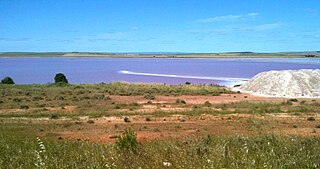
The Hundred of Cameron is a cadastral unit of hundred located in the Mid North of South Australia centred on Lake Bumbunga. The northern Hummock Range occupies much of the western half of the area and the Adelaide-Port Augusta railway line runs near and parallel to the eastern boundary. It is one of the 16 hundreds of the County of Daly. It was named in 1869 by Governor James Fergusson for early pioneer Hugh Cameron.

Pink Lake is a small, circular, salty pink lake on the Western Highway just north of Dimboola, Australia. Granville Stapylton, part of the explorer Thomas Mitchell's 1836 expedition into western Victoria, reconnoitered Pink Lake on 20 July 1836.
The Lochiel railway line was a railway line that branched off the Adelaide-Port Augusta railway line at Bumbunga. It opened in 1926 and closed in 1981.




















